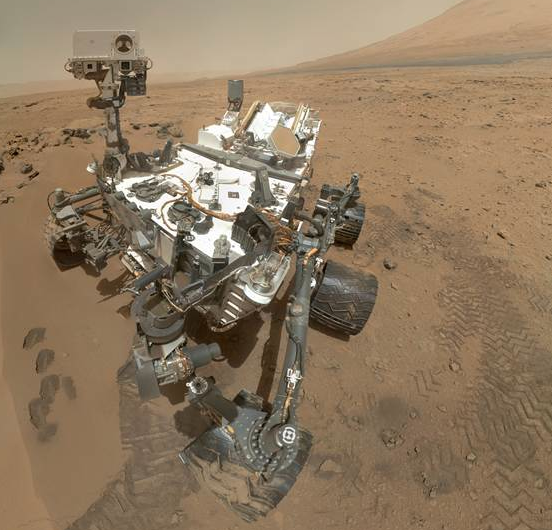Methane Is Scarce, But That Doesn’t Mean There’s No Life On Mars
Looking around for methane in Gale Crater, Curiosity found a whole lot of nothing. But that doesn't dash hopes of finding evidence of life on Mars some day.

Finding methane on another world is like finding breadcrumbs on a trail–it’s a telling clue, a detail that gives reason to ask more questions and maybe find some answers, in this case related to extraterrestrial life. This is why news from the Mars rover Curiosity late last week is kind of disappointing–looking around for methane, Curiosity found a whole lot of nothing.
But a dearth of methane does not necessarily dash hopes for finding evidence of life on Mars. And Curiosity could still obtain better measurements of the hydrocarbon, helping scientists understand how much there is and where it comes from. The methane mystery is far from over, said Geronimo Villanueva, a research assistant professor at Catholic University who is based at NASA’s Goddard Space Flight Center.
In general, methane is an indicator that something on the planet has changed, Villanueva explained. Mars’ tenuous atmosphere, which is only about 1 percent as thick as Earth’s, is very stable–a hallmark of a dead place. “For things to change, there has to be some sort of activity going on,” he said. “Either geological activity, and methane could be an indicator of that, or it could be an indicator of life.”
On Friday, scientists at the Jet Propulsion Laboratory said Curiosity’s Sample Analysis at Mars suite found almost none of it. Chris Webster, instrument lead for the Tunable Laser Spectrometer that’s part of SAM, said he could report with 95 percent confidence that Mars has between 0 and 5 parts per billion of methane. “The bottom line is that we have no detection of methane so far,” he told reporters. He also said the team has found evidence that Mars has lost at least half of its original air.

The Air On Mars
Something like 95 percent of Earth’s methane (four hydrogen atoms bound to one carbon atom) comes from living organisms, so it could be a beacon of life–which is why the lack of large amounts of Martian methane is somewhat disappointing for astrobiology. But the missing methane still doesn’t explain prior evidence for the gas on Mars. Villanueva is among those who have seen it.
Methane released into Mars’ atmosphere, by life or by something else, should stick around in a diluted form for about 300 years, Villanueva said. But he and others have detected methane in the recent past, only to see it disappear in later observations.
“We don’t know what that means. We should keep seeing it. It would get diluted, but nevertheless, there should be some remnant there,” he said.
In 2009, Villanueva and colleagues at Goddard reported a huge uptick in methane in the northern hemisphere of Mars six years prior. Huge plumes of the hydrocarbon leached into the atmosphere at a rate comparable to a famous, massive oil and gas seep in Santa Barbara, Calif. But in follow-up observations, using the Keck telescopes on Mauna Kea, the team didn’t see anything. Scientists still don’t know what caused this methane plume, or where it went.
Villanueva said if you took the 2003 methane signatures he and NASA’s Michael Mumma observed, and spread them throughout the entire Martian atmosphere, the concentration would be somewhere around 5 or 6 ppb–consistent with what Curiosity sees at Gale Crater. Why is that interesting? It indicates the methane release, now about 10 years old, is probably not a recurring feature. If it was, the atmosphere would gain more methane as time goes by. “If it happened, it happened once,” Villanueva said.
It’s also interesting because it means more methane might be found elsewhere on Mars, he added. Just because Curiosity doesn’t see it doesn’t mean it’s not somewhere else. Last week, Webster and other scientists at JPL were quick to point out that Curiosity will keep looking. For his part, Villanueva said he was surprised by the large error bar in the SAM team’s calculations–Curiosity can do better than a 95 percent confidence between zero and 5 ppb, he said, adding that he’s excited to see refined measurements.
Even if Curiosity nails down Mars methane concentrations with more accuracy, the gas might not be the result of life. There are plenty of explanations for meager methane on Mars–comets could deliver it, or it might be the result of interactions between long-ago groundwater and certain components of rock, like olivine, a mineral Curiosity just found. It’s also possible that Mars does have microbes, but they don’t produce methane, Villanueva said. There’s still a lot of research to do before those questions can be answered.
“Mars is so arid and such an inhospitable place, if you see even very small amounts of methane, they are relevant. You can be thinking about some subsurface activity, maybe geologic activity, or life,” Villanueva said. “But the gas by itself doesn’t tell you that much. You need to go beyond.”

Mars Methane Sources and Sinks